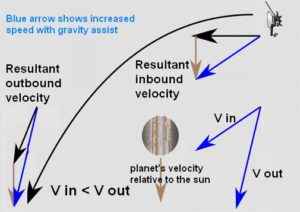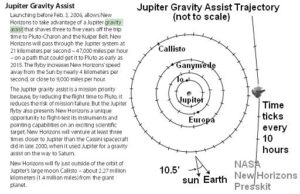
What Gives the Most Speed to a Spacecraft Flyby? It’s the Gravity Assist.
We use rockets to boost spacecraft beyond the Earth’s gravity and atmosphere. We use solar panels for renewable power, to operate scientific instruments. But what propels a spacecraft to the high speeds it needs in order to reach far into space, without being encumbered by heavy fuel?
If you have been uncertain about the physics of the gravity assist, you will appreciate the clarity of this explanation by David Shortt, in his September, 2013 Guest Blog at planetary.org. Shortt asks:
How Have We Humans Managed to Fling Objects So Far into Space?
With the recent announcement by NASA that the 36 year-old spacecraft Voyager 1 has officially entered interstellar space at a distance from the Sun about four times further than Neptune’s orbit, and with Voyager 2 not far behind, it seems worthwhile to explore how humans managed to fling objects so far into space.
Interplanetary spacecraft often use a maneuver called a gravity assist in order to reach their targets. Voyager 2 famously used gravity assists to visit Jupiter, Saturn, Uranus and Neptune in the late 1970s and 1980s. Cassini used two assists at Venus and one each at Earth and Jupiter in order to reach Saturn. New Horizons will arrive at Pluto in 2015 thanks to an assist at Jupiter. And Messenger used assists at Earth, Venus and three times at Mercury itself not to speed up, but to slow down enough to finally be captured by Mercury.
. . . Mission planners use gravity assists because they allow the objective to be accomplished with much less fuel (and hence with a much smaller, cheaper rocket) than would otherwise be required. Lifting extra fuel into orbit, just so it can be used later, is exponentially expensive. Furthermore, the extra speed gained by gravity assists dramatically reduces the duration of a mission to the outer planets.
Above article source: David Shortt’s 9/2013 guest blog

Above is an image from a NASA presskit of the deflection of the New Horizons flyby of Jupiter, on its way to Pluto, which increased the spacecraft’s speed away from the Sun by nearly 4 kilometers per second, or close to 9,000 miles per hour.
Above image and writeup source: NASA
Visit the next page to see Shortt’s elegantly simple explanation of the physics behind the gravity assist.



